Tanzania
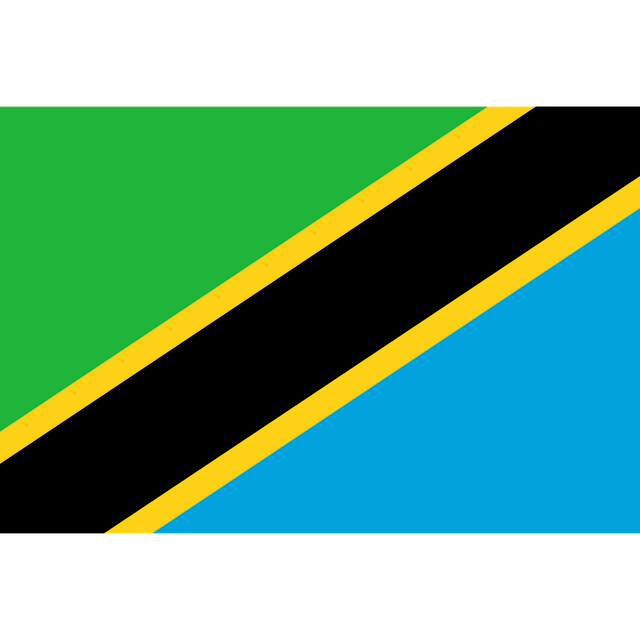
Tanzania

United Republic of Tanzania Jamhuri ya Muungano wa Tanzania(Swahili) | |
|---|---|
Motto:"Uhuru na Umoja"(Swahili) "Freedom and Unity" | |
Anthem:"Mungu ibariki Afrika" (English:"God Bless Africa") | |
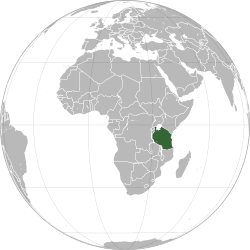 | |
 | |
| Capital | Dodoma (de jure) |
| Largest city | Dar es Salaam |
| Recognised national languages | Swahili[3] |
| Recognised regional languages | Arabic (official in Zanzibar) |
| Official Language | |
| Demonym(s) | Tanzanian |
| Government | Unitary dominant party presidential constitutional republic[4][5][6] |
• President | John Magufuli |
• Vice-President | Samia Hassan Suluhu |
• Prime Minister | Kassim Majaliwa |
• Speaker | Job Ndugai |
• Chief Justice | Ibrahim Hamis Juma |
| Legislature | National Assembly |
| Independencefrom the United Kingdom | |
• Tanganyika | 9 December 1961 |
• Unguja and Pemba | 10 December 1963 |
• Merger | 26 April 1964 |
• Current constitution | 25 April 1977 |
| Area | |
• Total | 947,303 km2(365,756 sq mi) (31st) |
• Water (%) | 6.4[7] |
| Population | |
• 2016 estimate | 55,572,201[8] (26th) |
• 2012 census | 44,928,923[9] |
• Density | 47.5/km2(123.0/sq mi) |
| GDP(PPP) | 2019 estimate |
• Total | $186.060 billion |
• Per capita | $3,574[10] |
| GDP(nominal) | 2019 estimate |
• Total | $61.032 billion |
• Per capita | $1,172[10] |
| Gini(2012) | 37.8[11] medium |
| HDI(2017) | low · 154th |
| Currency | Tanzanian shilling (TZS) |
| Time zone | UTC+3(EAT) |
| Driving side | left |
| Calling code | +255[1] |
| ISO 3166 code | TZ |
| Internet TLD | .tz |
Tanzania (/ˌtænzəˈniːə/,[14][15][2] Swahili: [tanzaˈni.a]) officially the United Republic of Tanzania (Swahili: Jamhuri ya Muungano wa Tanzania), is a country in East Africa within the African Great Lakes region. It borders Uganda to the north; Kenya to the northeast; Comoro Islands at the Indian Ocean to the east; Mozambique and Malawi to the south; Zambia to the southwest; and Rwanda, Burundi, and the Democratic Republic of the Congo to the west. Mount Kilimanjaro, Africa's highest mountain, is in north-eastern Tanzania.
Many important hominid fossils have been found in Tanzania, such as 6 million year-old Pliocene hominid fossils. The genus Australopithecus ranged all over Africa 4-2 million years ago; and the oldest remains of the genus Homo are found near Lake Olduvai. Following the rise of Homo erectus 1.8 million years ago, mankind spread all over the Old World, and later in the New World and Australia under the species Homo sapiens. Homo sapiens also overtook Africa and absorbed the older archaic species and subspecies of humanity. One of the oldest known ethnic groups still existing, the Hadzabe, appears to have originated in Tanzania, and their oral history recalls ancestors who were tall and were the first to use fire, medicine, and lived in caves, much like Homo erectus or Homo heidelbergensis who lived in the same region before them.
Later in the Stone and Bronze Age, prehistoric migrations into Tanzania included Southern Cushitic speakers who moved south from present-day Ethiopia;[16] Eastern Cushitic people who moved into Tanzania from north of Lake Turkana about 2,000 and 4,000 years ago;[16] and the Southern Nilotes, including the Datoog, who originated from the present-day South Sudan–Ethiopia border region between 2,900 and 2,400 years ago.[16] [] These movements took place at about the same time as the settlement of the Mashariki Bantu from West Africa in the Lake Victoria and Lake Tanganyika areas. They subsequently migrated across the rest of Tanzania between 2,300 and 1,700 years ago.[16][17]
German rule began in mainland Tanzania during the late 19th century when Germany formed German East Africa. This was followed by British rule after World War I. The mainland was governed as Tanganyika, with the Zanzibar Archipelago remaining a separate colonial jurisdiction. Following their respective independence in 1961 and 1963, the two entities merged in April 1964 to form the United Republic of Tanzania.[18]
The United Nations estimated Tanzania's 2016 population at 55.57 million.[8] The population is composed of several ethnic, linguistic, and religious groups. The sovereign state of Tanzania is a presidential constitutional republic and since 1996 its official capital city has been Dodoma where the president's office, the National Assembly, and some government ministries are located.[19] Dar es Salaam, the former capital, retains most government offices and is the country's largest city, principal port, and leading commercial centre.[18][20][21] Tanzania is a de facto one-party state with the democratic socialist Chama Cha Mapinduzi party in power.
Tanzania is mountainous and densely forested in the north-east, where Mount Kilimanjaro is located. Three of Africa's Great Lakes are partly within Tanzania. To the north and west lie Lake Victoria, Africa's largest lake, and Lake Tanganyika, the continent's deepest lake, known for its unique species of fish. To the south lies Lake Malawi. The eastern shore is hot and humid, with the Zanzibar Archipelago just offshore. The Menai Bay Conservation Area is Zanzibar's largest marine protected area. The Kalambo Falls, located on the Kalambo River at the Zambian border, is the second highest uninterrupted waterfall in Africa.[22]
Over 100 different languages are spoken in Tanzania, making it the most linguistically diverse country in East Africa.[23] The country does not have a de jure official language, although the national language is Swahili.[24] Swahili is used in parliamentary debate, in the lower courts, and as a medium of instruction in primary school. English is used in foreign trade, in diplomacy, in higher courts, and as a medium of instruction in secondary and higher education,[23] although the Tanzanian government is planning to discontinue English as a language of instruction altogether.[25] Approximately 10 percent of Tanzanians speak Swahili as a first language, and up to 90 percent speak it as a second language.[23]
United Republic of Tanzania Jamhuri ya Muungano wa Tanzania(Swahili) | |
|---|---|
Motto:"Uhuru na Umoja"(Swahili) "Freedom and Unity" | |
Anthem:"Mungu ibariki Afrika" (English:"God Bless Africa") | |
 | |
 | |
| Capital | Dodoma (de jure) |
| Largest city | Dar es Salaam |
| Recognised national languages | Swahili[3] |
| Recognised regional languages | Arabic (official in Zanzibar) |
| Official Language | |
| Demonym(s) | Tanzanian |
| Government | Unitary dominant party presidential constitutional republic[4][5][6] |
• President | John Magufuli |
• Vice-President | Samia Hassan Suluhu |
• Prime Minister | Kassim Majaliwa |
• Speaker | Job Ndugai |
• Chief Justice | Ibrahim Hamis Juma |
| Legislature | National Assembly |
| Independencefrom the United Kingdom | |
• Tanganyika | 9 December 1961 |
• Unguja and Pemba | 10 December 1963 |
• Merger | 26 April 1964 |
• Current constitution | 25 April 1977 |
| Area | |
• Total | 947,303 km2(365,756 sq mi) (31st) |
• Water (%) | 6.4[7] |
| Population | |
• 2016 estimate | 55,572,201[8] (26th) |
• 2012 census | 44,928,923[9] |
• Density | 47.5/km2(123.0/sq mi) |
| GDP(PPP) | 2019 estimate |
• Total | $186.060 billion |
• Per capita | $3,574[10] |
| GDP(nominal) | 2019 estimate |
• Total | $61.032 billion |
• Per capita | $1,172[10] |
| Gini(2012) | 37.8[11] medium |
| HDI(2017) | low · 154th |
| Currency | Tanzanian shilling (TZS) |
| Time zone | UTC+3(EAT) |
| Driving side | left |
| Calling code | +255[1] |
| ISO 3166 code | TZ |
| Internet TLD | .tz |
Etymology
The name "Tanzania" was created as a clipped compound of the names of the two states that unified to create the country: Tanganyika and Zanzibar.[26] It consists of the first three letters of the names of the two states ("Tan" and "Zan") and the suffix, "ia" to form Tanzania.
The name "Tanganyika" is derived from the Swahili words tanga ("sail") and nyika ("uninhabited plain", "wilderness"), creating the phrase "sail in the wilderness". It is sometimes understood as a reference to Lake Tanganyika.[27]
The name of Zanzibar comes from "zenji", the name for a local people (said to mean "black"), and the Arabic word "barr", which means coast or shore.[28]
History
Ancient
The first wave of migration was by Southern Cushitic speakers who moved south from Ethiopia and Somalia into Tanzania. They are ancestral to the Iraqw, Gorowa, and Burunge.[16] [] Based on linguistic evidence, there may also have been two movements into Tanzania of Eastern Cushitic people at about 4,000 and 2,000 years ago, originating from north of Lake Turkana.[16] []
Archaeological evidence supports the conclusion that Southern Nilotes, including the Datoog, moved south from the present-day South Sudan / Ethiopia border region into central northern Tanzania between 2,900 and 2,400 years ago.[16] []
These movements took place at approximately the same time as the settlement of the iron-making Mashariki Bantu from West Africa in the Lake Victoria and Lake Tanganyika areas. They brought with them the west African planting tradition and the primary staple of yams. They subsequently migrated out of these regions across the rest of Tanzania between 2,300 and 1,700 years ago.[16][17]
The people of Tanzania have been associated with the production of iron and steel. The Pare people were the main producers of highly demanded iron for peoples who occupied the mountain regions of north-eastern Tanzania.[30] The Haya people on the western shores of Lake Victoria invented a type of high-heat blast furnace, which allowed them to forge carbon steel at temperatures exceeding 1,820 °C (3,310 °F) more than 1,500 years ago.[31]
Colonial
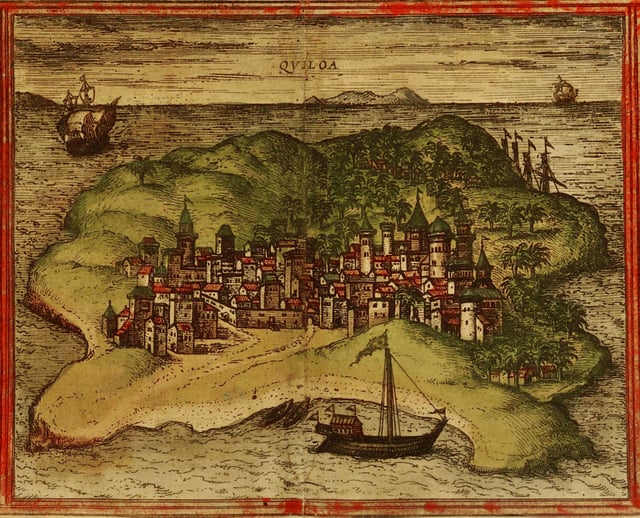
A 1572 depiction of the city of Kilwa, a UNESCO World Heritage Site
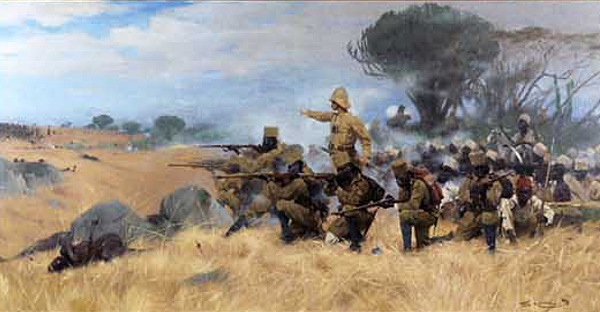
The Maji Maji Rebellion against German colonial rule in 1905
Claiming the coastal strip, Omani Sultan Said bin Sultan moved his capital to Zanzibar City in 1840. During this time, Zanzibar became the centre for the Arab slave trade.[34] Between 65 and 90 percent of the Arab-Swahili population of Zanzibar was enslaved.[35] One of the most infamous slave traders on the East African coast was Tippu Tip, who was the grandson of an enslaved African. The Nyamwezi slave traders operated under the leadership of Msiri and Mirambo.[36] According to Timothy Insoll, "Figures record the exporting of 718,000 slaves from the Swahili coast during the 19th century, and the retention of 769,000 on the coast."[37] In the 1890s, slavery was abolished.[38]
In the late 19th century, Germany conquered the regions that are now Tanzania (minus Zanzibar) and incorporated them into German East Africa (GEA). The Supreme Council of the 1919 Paris Peace Conference awarded all of GEA to Britain on 7 May 1919, over the strenuous objections of Belgium.[39] [] The British colonial secretary, Alfred Milner, and Belgium's minister plenipotentiary to the conference, Pierre Orts, then negotiated the Anglo-Belgian agreement of 30 May 1919[40] [] where Britain ceded the north-western GEA provinces of Ruanda and Urundi to Belgium.[39] [] The conference's Commission on Mandates ratified this agreement on 16 July 1919.[39] [] The Supreme Council accepted the agreement on 7 August 1919.[40] [] On 12 July 1919, the Commission on Mandates agreed that the small Kionga Triangle south of the Rovuma River would be given to Portuguese Mozambique,[39] [] with it eventually becoming part of independent Mozambique. The commission reasoned that Germany had virtually forced Portugal to cede the triangle in 1894.[39] [] The Treaty of Versailles was signed on 28 July 1919, although the treaty did not take effect until 10 January 1920. On that date, the GEA was transferred officially to Britain, Belgium, and Portugal. Also on that date, "Tanganyika" became the name of the British territory.
During World War II, about 100,000 people from Tanganyika joined the Allied forces[41] and were among the 375,000 Africans who fought with those forces.[42] Tanganyikans fought in units of the King's African Rifles during the East African Campaign in Somalia and Abyssinia against the Italians, in Madagascar against the Vichy French during the Madagascar Campaign, and in Burma against the Japanese during the Burma Campaign.[42] Tanganyika was an important source of food during this war, and its export income increased greatly compared to the pre-war years of the Great Depression[41] Wartime demand, however, caused increased commodity prices and massive inflation within the colony.[43]
In 1954, Julius Nyerere transformed an organisation into the politically oriented Tanganyika African National Union (TANU). TANU's main objective was to achieve national sovereignty for Tanganyika. A campaign to register new members was launched, and within a year, TANU had become the leading political organisation in the country. Nyerere became Minister of British-administered Tanganyika in 1960 and continued as prime minister when Tanganyika became independent in 1961.
Modern
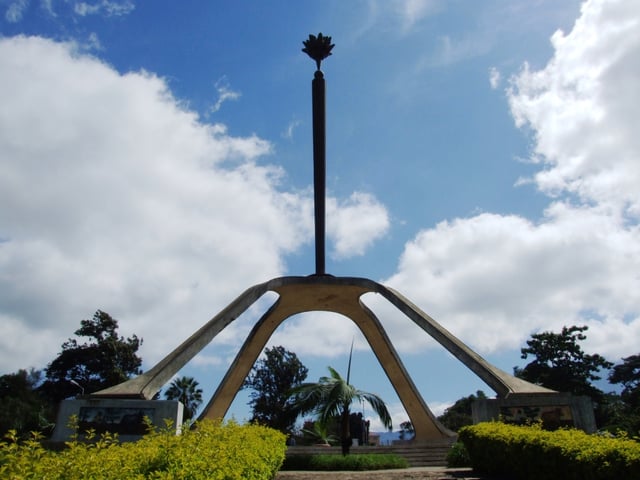
The Arusha Declaration Monument
After the Zanzibar Revolution overthrew the Arab dynasty in neighbouring Zanzibar,[45] which had become independent in 1963, the archipelago merged with mainland Tanganyika on 26 April 1964.[46] On 29 October of the same year, the country was renamed the United Republic of Tanzania ("Tan" comes from Tanganyika and "Zan" from Zanzibar).[18] The union of the two hitherto separate regions was controversial among many Zanzibaris (even those sympathetic to the revolution) but was accepted by both the Nyerere government and the Revolutionary Government of Zanzibar owing to shared political values and goals.
Following Tanganyika's independence and unification with Zanzibar leading to the state of Tanzania, President Nyerere emphasised a need to construct a national identity for the citizens of the new country. To achieve this, Nyerere provided what is regarded as one of the most successful cases of ethnic repression and identity transformation in Africa.[47] With over 130 languages spoken within its territory, Tanzania is one of the most ethnically diverse countries in Africa. Despite this obstacle, ethnic divisions remained rare in Tanzania when compared to the rest of the continent, notably its immediate neighbour, Kenya. Furthermore, since its independence, Tanzania has displayed more political stability than most African countries, particularly due to Nyerere's ethnic repression methods.[48]
In 1967, Nyerere's first presidency took a turn to the left after the Arusha Declaration, which codified a commitment to socialism as well as Pan-Africanism. After the declaration, banks and many large industries were nationalised.
Tanzania was also aligned with China, which from 1970 to 1975 financed and helped build the 1,860-kilometre-long (1,160 mi) TAZARA Railway from Dar es Salaam to Zambia.[49] Nonetheless, from the late 1970s, Tanzania's economy took a turn for the worse, in the context of an international economic crisis affecting both developed and developing economies.
From the mid-1980s, the regime financed itself by borrowing from the International Monetary Fund and underwent some reforms. Since then, Tanzania's gross domestic product per capita has grown and poverty has been reduced, according to a report by the World Bank.[50]
Geography
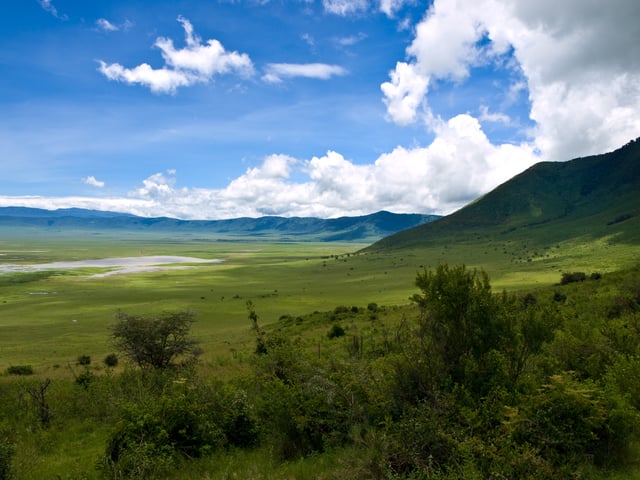
Ngorongoro Crater, the world's largest inactive and intact volcanic caldera
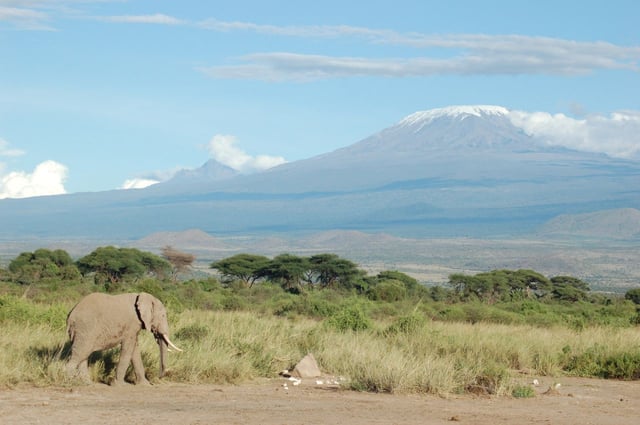
An elephant passing by the snow-capped Mt. Kilimanjaro

Tanzania map of Köppen climate classification

Wildebeest migration in the Serengeti
At 947,303 square kilometres (365,756 sq mi),[7] Tanzania is the 13th largest country in Africa and the 31st largest in the world, ranked between the larger Egypt and smaller Nigeria.[53] It borders Kenya and Uganda to the north; Rwanda, Burundi, and the Democratic Republic of the Congo to the west; and Zambia, Malawi, and Mozambique to the south. Tanzania is located on the eastern coast of Africa and has an Indian Ocean coastline approximately 1,424 kilometres (885 mi) long.[54] It also incorporates several offshore islands, including Unguja (Zanzibar), Pemba, and Mafia.[55] [] The country is the site of Africa's highest and lowest points: Mount Kilimanjaro, at 5,895 metres (19,341 ft) above sea level, and the floor of Lake Tanganyika, at 352 metres (1,155 ft) below sea level, respectively.[55] []
Tanzania is mountainous and densely forested in the northeast, where Mount Kilimanjaro is located. Three of Africa's Great Lakes are partly within Tanzania. To the north and west lie Lake Victoria, Africa's largest lake, and Lake Tanganyika, the continent's deepest lake, known for its unique species of fish. To the southwest lies Lake Nyasa. Central Tanzania is a large plateau, with plains and arable land. The eastern shore is hot and humid, with the Zanzibar Archipelago just offshore.
Kalambo Falls in the southwestern region of Rukwa is the second highest uninterrupted waterfall in Africa, and is located near the southeastern shore of Lake Tanganyika on the border with Zambia.[22] The Menai Bay Conservation Area is Zanzibar's largest marine protected area.
Climate
Climate varies greatly within Tanzania. In the highlands, temperatures range between 10 and 20 °C (50 and 68 °F) during cold and hot seasons respectively. The rest of the country has temperatures rarely falling lower than 20 °C (68 °F). The hottest period extends between November and February (25–31 °C or 77.0–87.8 °F) while the coldest period occurs between May and August (15–20 °C or 59–68 °F). Annual temperature is 20 °C (68.0 °F). The climate is cool in high mountainous regions.
Tanzania has two major rainfall regimes: one is uni-modal (October–April) and the other is bi-modal (October–December and March–May).[56] The former is experienced in southern, central, and western parts of the country, and the latter is found in the north from Lake Victoria extending east to the coast.[56] The bi-modal regime is caused by the seasonal migration of the Intertropical Convergence Zone.[56]
Wildlife and conservation
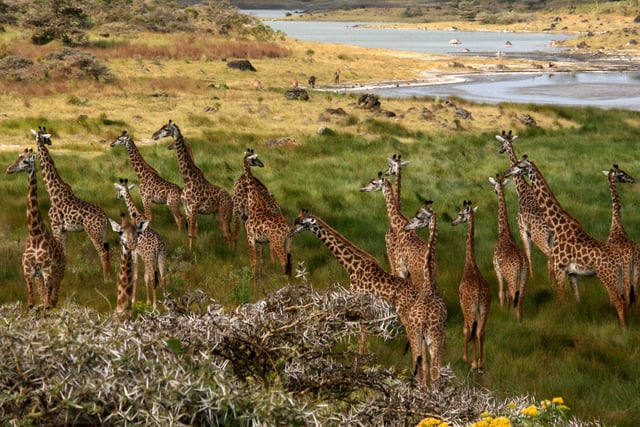
A tower of giraffes at Arusha National Park. The giraffe is the national animal.
Approximately 38 percent of Tanzania's land area is set aside in protected areas for conservation.[57] Tanzania has 16 national parks,[58] plus a variety of game and forest reserves, including the Ngorongoro Conservation Area. In western Tanzania, Gombe Stream National Park is the site of Jane Goodall's ongoing study of chimpanzee behaviour, which started in 1960.[59][60]
Tanzania is highly biodiverse and contains a wide variety of animal habitats.[61] On Tanzania's Serengeti plain, white-bearded wildebeest (Connochaetes taurinus mearnsi), other bovids and zebra [62] participate in a large-scale annual migration. Tanzania is home to about 130 amphibian and over 275 reptile species, many of them strictly endemic and included in the International Union for Conservation of Nature's Red Lists of countries.[63]
Politics
Government
John Magufuli won the October 2015 presidential election and secured a two-thirds majority in parliament.[65] The other party or main opposition party in Tanzania is called Chama cha Demokrasia na Maendeleo (Chadema) (Swahili for "Party for Democracy and Progress"). In Zanzibar, the Civil United Front (CUF) is considered a main opposition political party.
Executive

Prime Minister Kassim Majaliwa
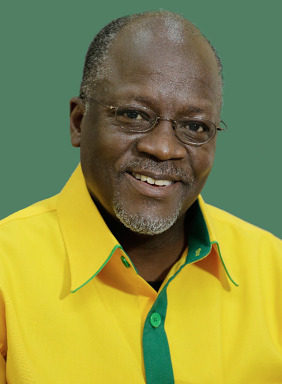
President John Magufuli
The president of Tanzania and the members of the National Assembly are elected concurrently by direct popular vote for five-year terms.[64] [] The vice-president is elected for a five-year term at the same time as the president and on the same ticket.[64] [] Neither the president nor the vice-president may be a member of the National Assembly.[64] [] The president appoints a prime minister, subject to confirmation by the assembly, to serve as the government's leader in the assembly.[64] [] The president selects his or her cabinet from assembly members.[64] []
Legislature
All legislative power relating to mainland Tanzania and union matters is vested in the National Assembly,[64] [] which is unicameral and has a maximum of 357 members.[66] These include members elected to represent constituencies, the attorney general, five members elected by the Zanzibar house of representatives from among its own members, the special women's seats that constitute at least 30% of the seats that any party has in the assembly, the speaker of the assembly (if not otherwise a member of the assembly), and the persons (not more than ten) appointed by the president.[64] [] The Tanzania Electoral Commission demarcates the mainland into constituencies in the number determined by the commission with the consent of the president.[64] []
Judiciary
Tanzania's legal system is based on English common law.[67]
Tanzania has a four-level judiciary.[67] The lowest-level courts on the Tanzanian mainland are the Primary Courts.[67] In Zanzibar, the lowest-level courts are the Kadhi's Courts for Islamic family matters and the Primary Courts for all other cases.[67] On the mainland, appeal is to either the District Courts or the Resident Magistrates Courts.[67] In Zanzibar, appeal is to the Kadhi's Appeal Courts for Islamic family matters and the Magistrates Courts for all other cases.[67] From there, appeal is to the High Court of Mainland Tanzania or Zanzibar.[67] No appeal regarding Islamic family matters can be made from the High Court of Zanzibar.[67][68] [] Otherwise, the final appeal is to the Court of Appeal of Tanzania.[67]
Tanzania is a party to the Rome Statute of the International Criminal Court.[72]
Human rights
People with albinism living in Tanzania are often attacked, killed or mutilated because of superstitions related to the black-magical practice known as muti that say body parts of albinos have magical properties.[75]
Tanzania has the highest occurrence of this human rights violation among 27 African countries where muti is known to be practised.[76]
Zanzibar

The semi-autonomous Zanzibar Archipelago
The Legislative Council has two parts: the president of Zanzibar and the House of Representatives.[64] [] [68] [] The president is Zanzibar's head of government and the chairman of the Revolutionary Council, in which the executive authority of Zanzibar is invested.[68] [] Zanzibar has two vice-presidents, with the first being from the main opposition party in the house.[77][78] The second is from the party in power and is the leader of government business in the House.[78]
The president selects ministers from members of the House of Representatives,[68] [] with the ministers allocated according to the number of House seats won by political parties.[77] The Revolutionary Council consists of the president, both vice-presidents, all ministers, the attorney general of Zanzibar, and other house members deemed fit by the president.[77]
The House of Representatives is composed of elected members, ten members appointed by the president, all the regional commissioners of Zanzibar, the attorney general, and appointed female members whose number must be equal to 30 percent of the elected members.[68] [] The House determines the number of its elected members[68] [] with the Zanzibar Electoral Commission determining the boundaries of each election constituency.[68] [] In 2013, the House had 81 members: fifty elected members, five regional commissioners, the attorney general, ten members appointed by the president, and fifteen appointed female members.[66]
Administrative subdivisions

Regions of Tanzania
In 1972, local government on the mainland was abolished and replaced with direct rule from the central government. Local government, however, was reintroduced in the beginning of the 1980s, when the rural councils and rural authorities were re-established. Local government elections took place in 1983, and functioning councils started in 1984. In 1999, a Local Government Reform Programme was enacted by the National Assembly, setting "a comprehensive and ambitious agenda ... [covering] four areas: political decentralization, financial decentralization, administrative decentralization and changed central-local relations, with the mainland government having overriding powers within the framework of the Constitution."[79]
As of 2016, Tanzania is divided into thirty-one regions. regions (mkoa),[80][81] twenty-six on the mainland and five in Zanzibar (three on Unguja, two on Pemba).[82] In 2012, the thirty former regions were divided into 169 districts (wilaya), also known as local government authorities. Of those districts, 34 were urban units, which were further classified as three city councils (Arusha, Mbeya, and Mwanza), nineteen municipal councils, and twelve town councils.[9]
The urban units have an autonomous city, municipal, or town council and are subdivided into wards and mtaa. The non-urban units have an autonomous district council but are subdivided into village councils or township authorities (first level) and then into vitongoji.[79]
The city of Dar es Salaam is unique because it has a city council whose areal jurisdiction overlaps three municipal councils. The mayor of the city council is elected by that council. The twenty-member city council is composed of eleven persons elected by the municipal councils, seven members of the National Assembly, and "Nominated members of parliament under 'Special Seats' for women". Each municipal council also has a mayor. "The City Council performs a coordinating role and attends to issues cutting across the three municipalities", including security and emergency services.[83][84] The city of Mwanza has a city council whose areal jurisdiction overlaps two municipal councils.
Foreign relations
Bilateral relations
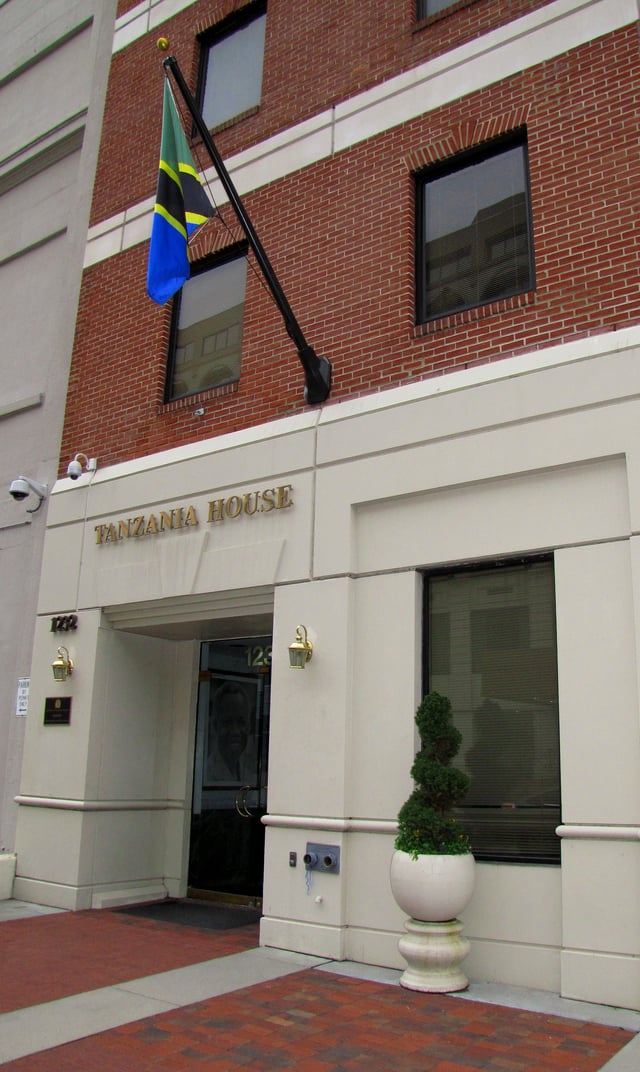
Tanzanian Embassy in West End, Washington, D.C., USA
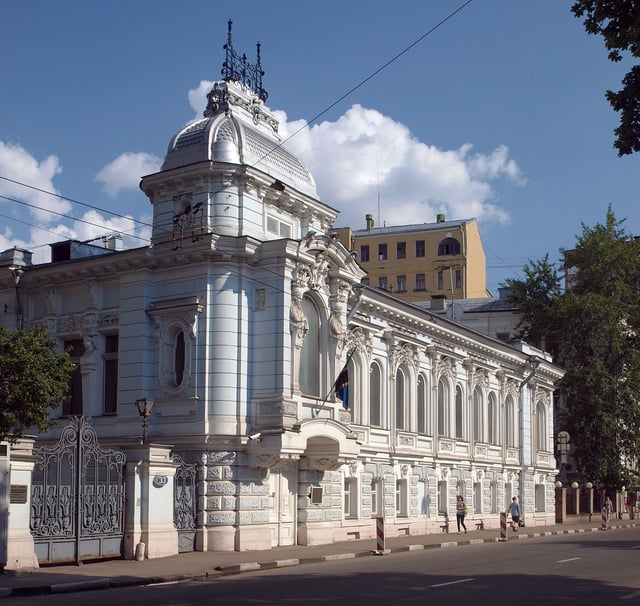
Embassy of Tanzania in Moscow, Russia
Apart from its border dispute with Malawi, Tanzania had cordial relations with its neighbours in 2012.[85]
Relations between Tanzania and Malawi have been tense because of a dispute over the countries' Lake Nyasa (Lake Malawi) border. An unsuccessful mediation regarding this issue took place in March 2014.[55] [] [85][86] The two countries agreed in 2013 to ask the International Court of Justice (ICJ) to resolve the dispute should mediation be unsuccessful.[87] Malawi, but not Tanzania, has accepted the compulsory jurisdiction of the ICJ.[88]
Relations between Tanzania and Rwanda deteriorated in 2013 when Tanzanian President Jakaya Kikwete said that if the Democratic Republic of the Congo (DRC) could negotiate with some of its enemies, Rwanda should be able to do the same.[89] Rwandan President Paul Kagame then expressed "contempt" for Kikwete's statement.[90] The tension was renewed in May 2014 when, in a speech to the Tanzanian National Assembly, Foreign Affairs Minister Bernard Membe renewed his claim that Rwandans were causing instability in the DRC. Rwandan Foreign Affairs Minister Louise Mushikiwabo responded, "As for Tanzania's foreign minister whose anti-Rwanda rant in parliament I heard, he would benefit from a lesson in the history of the region."[91]
Multilateral relations
Tanzania is a member of the East African Community (EAC), along with Uganda, Kenya, Rwanda, and Burundi.[95] According to the East African Common Market Protocol of 2010, the free trade and free movement of people is guaranteed, including the right to reside in another member country for purposes of employment.[55] [] [96][97] This protocol, however, has not been implemented because of work permit and other bureaucratic, legal, and financial obstacles.[98]
Tanzania is also a member of the Southern African Development Community (SADC).[99] The EAC, the SADC, and the Common Market for Eastern and Southern Africa agreed in June 2011 to negotiate the creation of a Tripartite Free Trade Area spanning 26 African countries, with a goal to complete the first phase of negotiations within 36 months.[100]
As of 31 October 2014, Tanzania was contributing 2,253 soldiers and other personnel to various United Nations peacekeeping operations.[101] The Tanzanian military is participating along with South African and Malawian militaries in the United Nations Force Intervention Brigade (MONUSCO) in the Democratic Republic of the Congo (DRC). The United Nations Security Council authorised the force on 28 March 2013 to conduct targeted offensive operations to neutralise groups that threaten peace in the DRC.[102] Tanzania was also participating in peacekeeping missions in the Darfur Region of Sudan (UNAMID); Abyei, control of which is contested between South Sudan and Sudan (UNISFA); the Central African Republic (MINUSCA); Lebanon (UNIFIL); and South Sudan (UNMISS).[103]
Economy and infrastructure

Bank of Tanzania Twin Towers
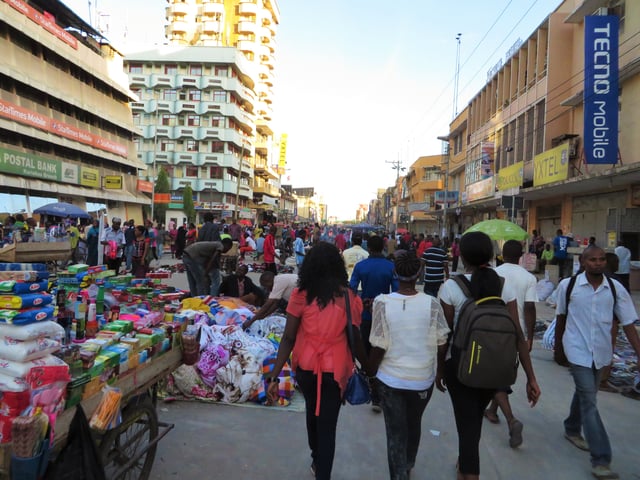
The Kariakoo market in Dar es Salaam
As of 2018, according to the IMF, Tanzania's gross domestic product (GDP) was an estimated $56.7 billion (nominal), or $176.5 billion on a purchasing power parity (PPP) basis. GDP per capita (PPP) was $3,457.[104]
From 2009 through 2013, Tanzania's per capita GDP (based on constant local currency) grew an average of 3.5% per year, higher than any other member of the East African Community (EAC) and exceeded by only nine countries in Sub-Saharan Africa: the Democratic Republic of the Congo, Ethiopia, Ghana, Lesotho, Liberia, Mozambique, Sierra Leone, Zambia, and Zimbabwe.[105]
Tanzania's largest trading partners in 2017 for its US$5.3 billion in exports were India, Vietnam, South Africa, Switzerland, and China.[106] Its imports totalled US$8.17 billion, with India, Switzerland, Saudi Arabia, China, and the United Arab Emirates being the biggest partners.[106]
Tanzania weathered the Great Recession, which began in late 2008 or early 2009, relatively well. Strong gold prices, bolstering the country's mining industry, and Tanzania's poor integration into global markets helped to insulate the country from the downturn.[55] [] Since the recession ended, the Tanzanian economy has expanded rapidly thanks to strong tourism, telecommunications, and banking sectors.[55] []
According to the United Nations Development Program, however, recent growth in the national economy has benefited only the "very few", leaving out the majority of the population.[107] Tanzania's 2013 Global Hunger Index was worse than any other country in the EAC except Burundi.[108] [] The proportion of persons who were undernourished in 2010–12 was also worse than any other EAC country except Burundi.[108] []
More about Tanzania
Tanzania has made some progress towards reducing extreme hunger and malnutrition. The Global Hunger Index ranked the situation as “alarming” with a score of 42 in the year 2000, since then the GHI has declined to 29.5.[109] Children in rural areas suffer substantially higher rates of malnutrition and chronic hunger, although urban-rural disparities have narrowed as regards both stunting and underweight.[110] Low rural sector productivity arises mainly from inadequate infrastructure investment; limited access to farm inputs, extension services and credit; limited technology as well as trade and marketing support; and heavy dependence on rain-fed agriculture and natural resources.[110]
Approximately 68 percent of Tanzania's 44.9 million citizens live below the poverty line of $1.25 a day. 32 percent of the population are malnourished.[109] The most prominent challenges Tanzania faces in poverty reduction are unsustainable harvesting of its natural resources, unchecked cultivation, climate change and water- source encroachment, according to the United Nations Development Programme (UNDP).[111]
There are very few resources for Tanzanians in terms of credit services, infrastructure or availability to improved agricultural technologies, which further exacerbates hunger and poverty in the country according to the UNDP.[111] Tanzania ranks 159 out of 187 countries in poverty according to the United Nation's Human Development Index (2014).[111]
Agriculture

Tea fields in Tukuyu
The Tanzanian economy is heavily based on agriculture, which in 2013 accounted for 24.5 percent of gross domestic product,[44] [] provides 85% of exports,[18] and accounted for half of the employed workforce;[44] [] The agricultural sector grew 4.3 percent in 2012, less than half of the Millennium Development Goal target of 10.8%.[112] 16.4 percent of the land is arable,[113] with 2.4 percent of the land planted with permanent crops.[114] Tanzania's economy relies on farming, but climate change has impacted their farming.
Maize was the largest food crop on the Tanzania mainland in 2013 (5.17 million tonnes), followed by cassava (1.94 million tonnes), sweet potatoes (1.88 million tonnes), beans (1.64 million tonnes), bananas (1.31 million tonnes), rice (1.31 million tonnes), and millet (1.04 million tonnes).[44] [] Sugar was the largest cash crop on the mainland in 2013 (296,679 tonnes), followed by cotton (241,198 tonnes), cashew nuts (126,000 tonnes), tobacco (86,877 tonnes), coffee (48,000 tonnes), sisal (37,368 tonnes), and tea (32,422 tonnes).[44] [] Beef was the largest meat product on the mainland in 2013 (299,581 tonnes), followed by lamb/mutton (115,652 tonnes), chicken (87,408 tonnes), and pork (50,814 tonnes).[44] []
According to the 2002 National Irrigation Master Plan, 29.4 million hectares in Tanzania are suitable for irrigation farming; however, only 310,745 hectares were actually being irrigated in June 2011.[115]
Industry, energy and construction
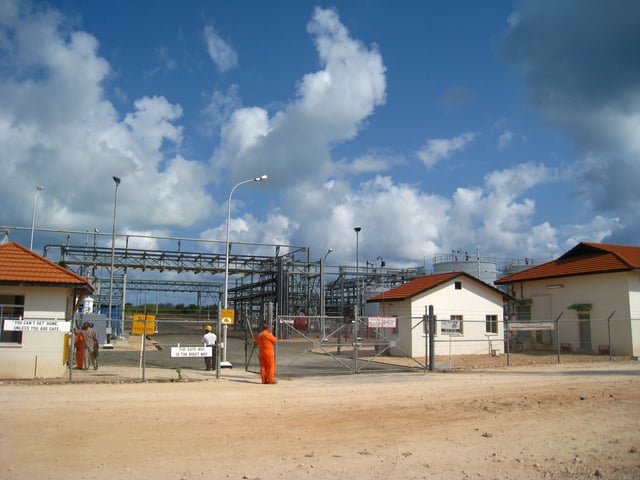
Songo Songo Gas Plant

Williamson diamond mine
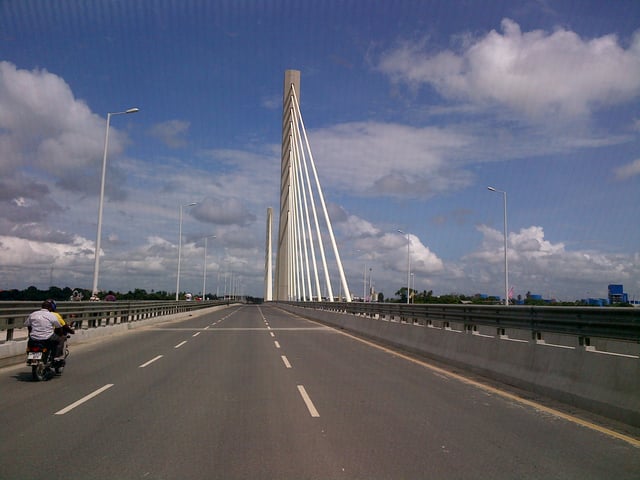
Nyerere Bridge in Kigamboni, Dar es Salaam, is Tanzania's (and East Africa's) only suspension bridge.
Industry and construction is a major and growing component of the Tanzanian economy, contributing 22.2 percent of GDP in 2013.[44] [] This component includes mining and quarrying, manufacturing, electricity and natural gas, water supply, and construction.[44] [] Mining contributed 3.3 percent of GDP in 2013.[44] [] The vast majority of the country's mineral export revenue comes from gold, accounting for 89 percent of the value of those exports in 2013.[44] [] It also exports sizeable quantities of gemstones, including diamonds and tanzanite.[55] [] All of Tanzania's coal production, which totalled 106,000 short tons in 2012, is used domestically.[116]
Only 15 percent of Tanzanians had access to electric power in 2011.[117] The government-owned Tanzania Electric Supply Company Limited (TANESCO) dominates the electric supply industry in Tanzania.[118] The country generated 6.013 billion kilowatt hours (kWh) of electricity in 2013, a 4.2 percent increase over the 5.771 billion kWh generated in 2012.[119] [] Generation increased by 63 percent between 2005 and 2012;[120][121] Almost 18 percent of the electricity generated in 2012 was lost because of theft and transmission and distribution problems.[120] The electrical supply varies, particularly when droughts disrupt hydropower electric generation; rolling blackouts are implemented as necessary.[55] [] [118] The unreliability of the electrical supply has hindered the development of Tanzanian industry.[55] [] In 2013, 49.7 percent of Tanzania's electricity generation came from natural gas, 28.9 percent from hydroelectric sources, 20.4 percent from thermal sources, and 1.0 percent from outside the country.[119] [] The government has built a 532 kilometres (331 mi) gas pipeline from Mnazi Bay to Dar es Salaam.[122] This pipeline was expected to allow the country to double its electricity generation capacity to 3,000 megawatts by 2016.[123] The government's goal is to increase capacity to at least 10,000 megawatts by 2025.[124]
According to PFC Energy, 25 to 30 trillion cubic feet of recoverable natural gas resources have been discovered in Tanzania since 2010,[116] bringing the total reserves to over 43 trillion cubic feet by the end of 2013.[125] The value of natural gas actually produced in 2013 was US$52.2 million, a 42.7 percent increase over 2012.[44] []
Commercial production of gas from the Songo Songo Island field in the Indian Ocean commenced in 2004, thirty years after it was discovered there.[126][127] Over 35 billion cubic feet of gas was produced from this field in 2013,[44] [] with proven, probable, and possible reserves totalling 1.1 trillion cubic feet.[127] The gas is transported by pipeline to Dar es Salaam.[126] As of 27 August 2014, TANESCO owed the operator of this field, Orca Exploration Group Inc.[128]
The Ruvuma and Nyuna regions of Tanzania have been explored mostly by the discovery company that holds a 75 percent interest, Aminex, and has shown to hold in excess of 3.5 trillion cubic feet of natural gas. A pipeline connecting offshore natural gas fields to Tanzania's commercial capital Dar es Salaam was completed at the end of April 2015.[129]
Tourism
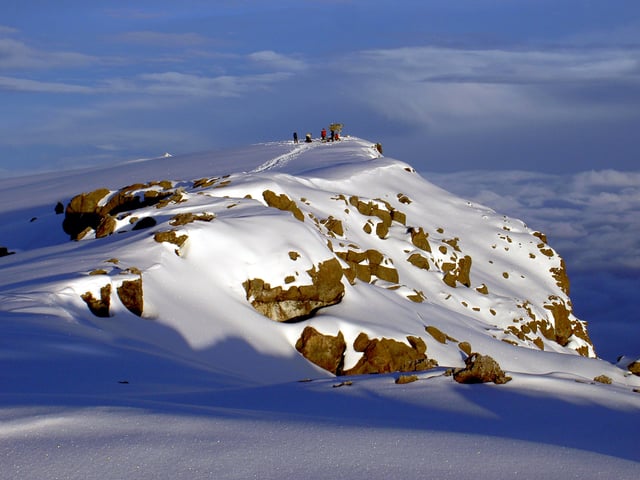
The snowcapped Uhuru Peak
Travel and tourism contributed 17.5 percent of Tanzania's gross domestic product in 2016[130] and employed 11.0 percent of the country's labour force (1,189,300 jobs) in 2013.[131] Overall receipts rose from US$1.74 billion in 2004 to US$4.48 billion in 2013,[131] and receipts from international tourists rose from US$1.255 billion in 2010 to US$2 billion in 2016.[130][132] In 2016, 1,284,279 tourists arrived at Tanzania's borders compared to 590,000 in 2005.[106] The vast majority of tourists visit Zanzibar or a "northern circuit" of Serengeti National Park, the Ngorongoro Conservation Area, Tarangire National Park, Lake Manyara National Park, and Mount Kilimanjaro.[55] [] In 2013, the most visited national park was Serengeti (452,485 tourists), followed by Manyara (187,773) and Tarangire (165,949).[44] []
Banking
The Bank of Tanzania is the central bank of Tanzania and is primarily responsible for maintaining price stability, with a subsidiary responsibility for issuing Tanzanian shilling notes and coins.[133] At the end of 2013, the total assets of the Tanzanian banking industry were 19.5 trillion Tanzanian shillings, a 15 percent increase over 2012.[134]
Transport
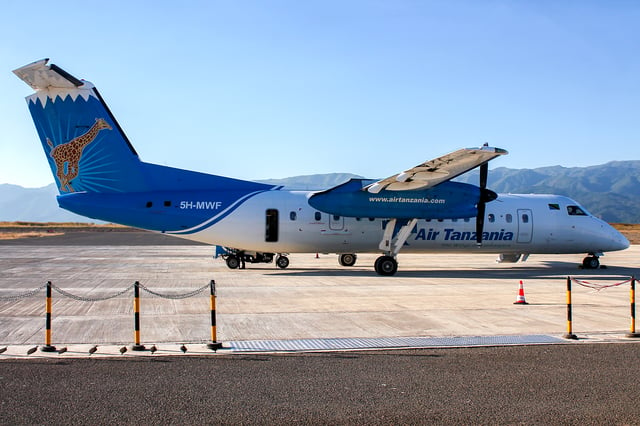
Air Tanzania is the country's flag carrier.
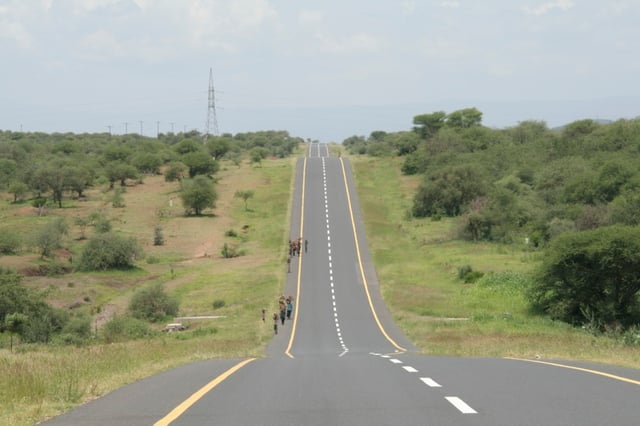
One of the main trunk roads
Most transport in Tanzania is by road, with road transport constituting over 75 percent of the country's freight traffic and 80 percent of its passenger traffic.[55] [] The 86,500 kilometres (53,700 mi) road system is in generally poor condition.[55] [] Tanzania has two railway companies: TAZARA, which provides service between Dar es Salaam and Kapiri Mposhi (in a copper-mining district in Zambia), and Tanzania Railways Limited, which connects Dar es Salaam with central and northern Tanzania.[55] [] Rail travel in Tanzania often entails slow journeys with frequent cancellations or delays, and the railways have a deficient safety record.[55] []
In Dar es Salaam, there is a huge project of rapid buses, Dar Rapid Transit (DART) which connects suburbs of Dar es Salaam city. The development of the DART system consists of six phases and is funded by the African Development Bank, the World Bank and the Government of Tanzania. The first phase began in April 2012, and it was completed in December 2015 and launched operations in May 2016.[135]
Communications
As of 2011, Tanzania had 56 mobile telephone subscribers per 100 inhabitants, a rate slightly above the sub-Saharan average.[55] [] Very few Tanzanians have fixed-line telephones.[55] [] Approximately 12 percent of Tanzanians used the internet as of 2011, though this number is growing rapidly.[55] [] The country has a fibre-optic cable network that replaced unreliable satellite service, but internet bandwidth remains very low.[55] []
Water supply and sanitation

Domestic expenditure on research in Southern Africa as a percentage of GDP, 2012 or closest year. Source: UNESCO Science Report: towards 2030 (2015), Figure 20.3
Water supply and sanitation in Tanzania has been characterised by decreasing access to improved water sources in the 2000s (especially in urban areas), steady access to some form of sanitation (around 93 percent since the 1990s), intermittent water supplies, and generally low quality of service.[136] Many utilities are barely able to cover their operation and maintenance costs through revenues because of low tariffs and poor efficiency. There are significant regional differences, with the best performing utilities being Arusha, Moshi, and Tanga.[137]
The government of Tanzania has embarked on a major sector reform process since 2002. An ambitious National Water Sector Development Strategy that promotes integrated water resources management and the development of urban and rural water supply was adopted in 2006. Decentralisation has meant that responsibility for water and sanitation service provision has shifted to local government authorities and is carried out by 20 urban utilities and about 100 district utilities, as well as by Community Owned Water Supply Organisations in rural areas.[136]
These reforms have been backed by a significant increase of the budget starting in 2006, when the water sector was included among the priority sectors of the National Strategy for Growth and Reduction of Poverty . The Tanzanian water sector remains heavily dependent on external donors, with 88 percent of the available funds being provided by external donor organisations.[138] Results have been mixed. For example, a report by Deutsche Gesellschaft für Internationale Zusammenarbeit noted that "despite heavy investments brought in by the World Bank and the European Union, (the utility serving Dar es Salaam) has remained one of the worst performing water entities in Tanzania."[139]
Food and nutrition
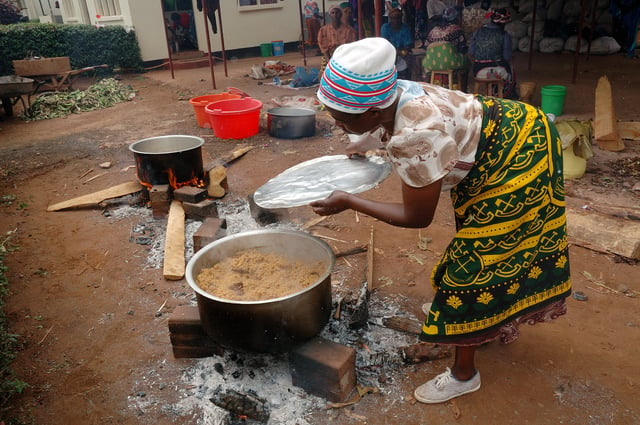
A Tanzanian woman cooks Pilau rice dish wearing traditional Kanga.
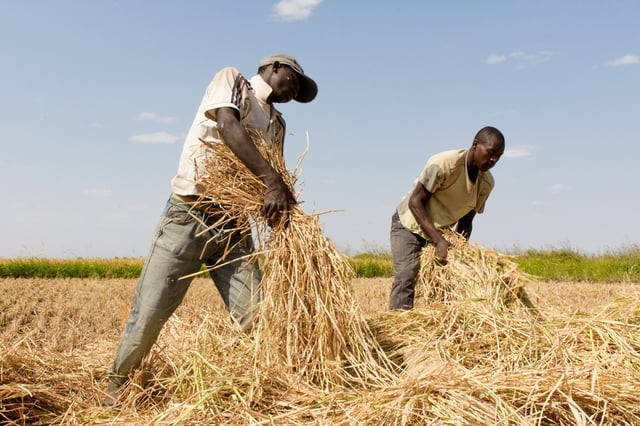
Farmers in Igunga District, Tanzania
Poor nutrition remains a persistent problem within Tanzania and varies hugely throughout the country's regions. USAID reports that 16% of children are underweight and 34% experience stunted growth as a result of malnutrition.[140] 10 regions house 58% of children suffering from stunted growth while 50% of acutely malnourished children can be found in 5 regions.[141] Over a 5-year period, the Mara district of Tanzania saw a 15% reduction in stunting in children under 5 years old, falling from 46% to 31% in 2005 and 2010 respectively. Dodoma, on the other hand saw a 7% increase in the prevalence of stunting in this age group, rising from 50% in 2005 to 57% in 2010.[142] Overall availability of food does not necessarily contribute to overall stunting figures. Iringa, Mbeya and Rukwa regions, where overall availability of food is considered acceptable still experience stunting incidences in excess of 50%. In some areas where food shortages are common such as in the Tabora and Singida regions, stunting incidences remain comparatively less than those seen in Iringa, Mbeya and Rukwa.[142] The Tanzania Food and Nutrition Centre attributes these discrepancies to variance in maternal malnutrition, poor infant feeding practices, hygiene practices and poor healthcare services.[142] Periods of drought can have significant impacts on the production of crops in Tanzania. Drought in East Africa has resulted in massive increases in the prices of food staples such as maize and sorghum, crops crucial to the nutrition of the majority of Tanzania's population. From 2015 to 2017, the price of maize when bought wholesale has more than doubled from 400 Shillings per kilogram to 1253 Shillings per kilogram respectively.[143]
Tanzania remains heavily agricultural, with 80% of the total population engaging in subsistence farming.[144] Rural areas are subjected to increased food shortages in comparison to urbanised areas, with a survey carried out within the country in 2017 finding 84% of people in rural areas suffering food shortages over a 3-month period compared to 64% of residents in cities.[144] This disparity between rural and city nutrition can be attributed to various factors; increased nutritional needs due to manual labour, more limited access to food as a result of poor infrastructure, high-susceptibility to the damaging effects of nature and the "Agricultural Productivity Gap".[145] The Agricultural Productivity Gap postulates that "value added per worker" is often much lower within the agricultural sector than that found within non-agricultural sectors. Furthermore, allocation of labour within the agricultural sector is largely allocated ineffectively.[146]
Programs targeting hunger
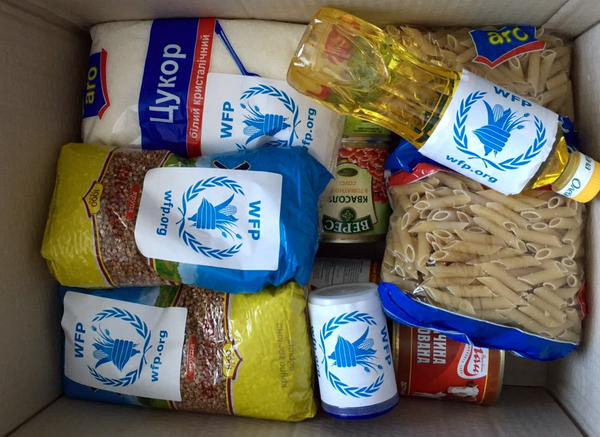
Example of a World Food Programme parcel
USAID programs focusing on nutrition operate within the Morogoro, Dodoma, Iringa, Mbeya, Manyara, Songwe and Zanzibar regions of Tanzania. These "Feed the Future" programs heavily invest in nutrition, infrastructure, policy, capacity of institutions and agriculture which is identified by the organisation as a key area of economic growth in the country.[140] A Tanzanian government led initiative "Kilimo Kwanza" or "Agriculture First" aims to encourage investment into agriculture within the private sector and hopes to improve agricultural processes and development within the country by seeking the knowledge of young people and the innovation that they can potentially provide.[147] During the 1990s, around 25% of Tanzania's population were provided access to iodized oil aimed to target iodine deficiency within expecting mothers, as result of studies showing the negative effects of in-utero iodine deficiency on cognitive development in children. Research showed that children of mothers with access to the supplement achieved on average greater than a third of a year more education than those who did not.[147]
Programmes led by the World Food Programme operate within Tanzania. The Supplementary Feeding Program (SFP) aims to target acute malnutrition by supplying blended food fortified with vitamins to pregnant women and mothers to children under 5 on a monthly basis.[148] Pregnant women and mothers to children under 2 have access to the Mother and Child Health and Nutrition Programme's "Super Cereal" which is supplied with the intent of reducing stunting in children.[148] World Food Programme supplementation remains the main food source for Tanzania's refugees. Super Cereal, Vegetable Oil, Pulses and Salt are supplied as part of the Protracted Relief and Recovery Operation in order to meet the average persons minimum daily caloric requirement of 2,100 kcal.[148] UNICEF state that continued investment in nutrition within Tanzania is of the utmost importance: Estimates predict that Tanzania stands to lose $20 billion by 2025 if nutrition within the country remains at its current level, however improvements in nutrition could produce a gain of around $4.7 billion[141]
Save the Children, with the help of UNICEF and Irish Aid funding created the Partnership for Nutrition in Tanzania (PANITA), in 2011. PANITA aims to utilise civil society organisations to specifically target nutrition within the country. Alongside this, various sectors associated with nutrition are targeted such as agriculture, water, sanitation, education, economic development and social progress. PANITA is responsible for ensuring significant attention is given to nutrition in development plans and budgets created on national and regional levels within Tanzania. Since its conception, PANITA has grown from 94 to 306 participating civil society organisations nationwide.[149] Agriculture within Tanzania is specifically targeted by the Irish Aid led initiative Harnessing Agriculture for Nutrition Outcomes (HANO), which aims to merge nutrition initiatives with agriculture in the Lindi District of the country. The project aims to reduce stunting by 10% in children aged 0 to 23 months.[149]
Science and technology

Researchers (HC) in Southern Africa per million inhabitants, 2013 or closest year

Scientific publications per million inhabitants in SADC countries in 2014. Source: UNESCO Science Report (2015), data from Thomson Reuters' Web of Science, Science Citation Index Expanded
Tanzania's first "National Science and Technology Policy" was adopted in 1996. The objective of the government's "Vision 2025" (1998) document was to "transform the economy into a strong, resilient and competitive one, buttressed by science and technology".
Under the umbrella of the One UN Initiative, UNESCO and Tanzanian government departments and agencies formulated a series of proposals in 2008 for revising the "National Science and Technology Policy". The total reform budget of US$10 million was financed from the One UN fund and other sources. UNESCO provided support for mainstreaming science, technology, and innovation into the new "National Growth and Poverty Reduction Strategy" for the mainland and Zanzibar namely, Mkukuta II and Mkuza II, including in the field of tourism.
Tanzania's revised science policy was published in 2010. Entitled "National Research and Development Policy", it recognises the need to improve the process of prioritisation of research capacities, develop international co-operation in strategic areas of research and development, and improve planning for human resources. It also makes provisions for the establishment of a National Research Fund. This policy was, in turn, reviewed in 2012 and 2013.[150]
In 2010, Tanzania devoted 0.38 percent of GDP to research and development. The global average in 2013 was 1.7 percent of GDP. Tanzania had 69 researchers (in head counts) per million population in 2010. In 2014, Tanzania counted 15 publications per million inhabitants in internationally catalogued journals, according to Thomson Reuters' Web of Science (Science Citation Index Expanded). The average for sub-Saharan Africa was 20 publications per million inhabitants and the global average 176 publications per million inhabitants.
Demographics
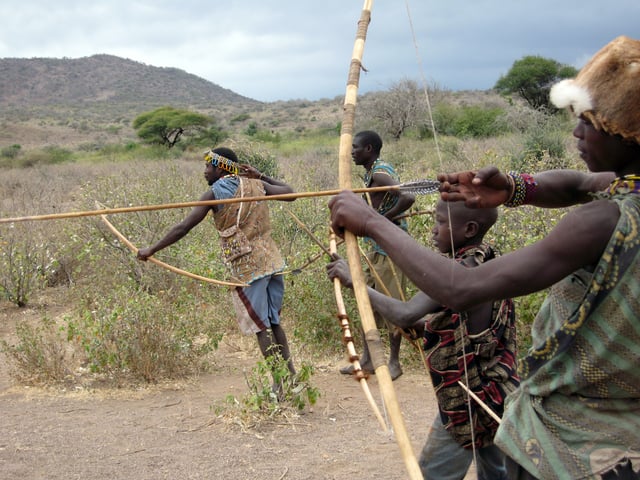
The Hadza live as hunter-gatherers.
| Year | Million |
|---|---|
| 1950 | 7.9 |
| 2000 | 35.1 |
| 2016 | 55.6 |
The population distribution in Tanzania is uneven. Most people live on the northern border or the eastern coast, with much of the remainder of the country being sparsely populated.[55] [] Density varies from 12 per square kilometre (31/sq mi) in the Katavi Region to 3,133 per square kilometre (8,110/sq mi) in the Dar es Salaam Region.[9] []
Approximately 70 percent of the population is rural, although this percentage has been declining since at least 1967.[152] Dar es Salaam (population 4,364,541)[153] is the largest city and commercial capital. Dodoma (population 410,956)[153] is located in the centre of Tanzania, is the capital of the country, and hosts the National Assembly.
The population consists of about 125 ethnic groups.[154] The Sukuma, Nyamwezi, Chagga, and Haya peoples each have a population exceeding 1 million.[155] [] Approximately 99 percent of Tanzanians are of native African descent, with small numbers of Arab, European, and Asian descent.[154] The majority of Tanzanians, including the Sukuma and the Nyamwezi, are Bantu.[156]
The population also includes people of Arab, Persian, and Indian origin, and small European and Chinese communities.[157] Many also identify as Shirazis. Thousands of Arabs, Persians, and Indians were massacred during the Zanzibar Revolution of 1964.[45] As of 1994, the Asian community numbered 50,000 on the mainland and 4,000 on Zanzibar. An estimated 70,000 Arabs and 10,000 Europeans lived in Tanzania.[158]
Some albinos in Tanzania have been the victims of violence in recent years.[159][160][161][162] Attacks are often to hack off the limbs of albinos in the perverse superstitious belief that possessing the bones of albinos will bring wealth. The country has banned witch doctors to try to prevent the practice, but it has continued and albinos remain targets.[163]
According to 2010 Tanzanian government statistics, the total fertility rate in Tanzania was 5.4 children born per woman, with 3.7 in urban mainland areas, 6.1 in rural mainland areas, and 5.1 in Zanzibar.[164] [] For all women aged 45–49, 37.3 percent had given birth to eight or more children, and for currently married women in that age group, 45.0 percent had given birth to that many children.[164] []
Religion

Gaddafi Mosque in the capital Dodoma is the second-largest mosque in East Africa.
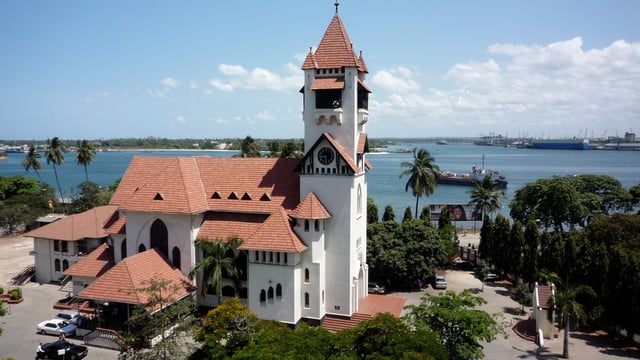
Azania Front Lutheran Church, built by German missionaries in 1898
Official statistics on religion are unavailable because religious surveys were eliminated from government census reports after 1967. Religious leaders and sociologists estimated in 2007 that Muslim and Christian communities were approximately equal in size, each accounting for 30 to 40 percent of the population, with the remainder consisting of practitioners of other faiths, indigenous religions, and people of "no religion".[165]
According to a 2014 estimate by the CIA World Factbook, 61.4 percent of the population was Christian, 35.2 percent was Muslim, 1.8 percent practised traditional African religions, 1.4 percent were unaffiliated with any religion, and 0.2 followed other religions. Nearly the entire population of Zanzibar is Muslim.[18] Of Muslims, 16 percent are Ahmadiyya (although they are often not considered Muslims), 20 percent are non-denominational Muslims, 40 percent are Sunni, 20 percent are Shia, and 4% are Sufi.[166]
The Christian population is mostly composed of Catholics and Protestants. Among Protestants, the large number of Lutherans and Moravians points to the German past of the country, while the number of Anglicans point to the British history of Tanganyika. Pentecostals and Adventists are also present because of missionary activity. All of them have had some influence in varying degrees from the Walokole movement (East African Revival), which has also been fertile ground for the spread of charismatic and Pentecostal groups.[167]
There are also active communities of other religious groups, primarily on the mainland, such as Buddhists, Hindus, and Bahá'ís.[168]
Languages
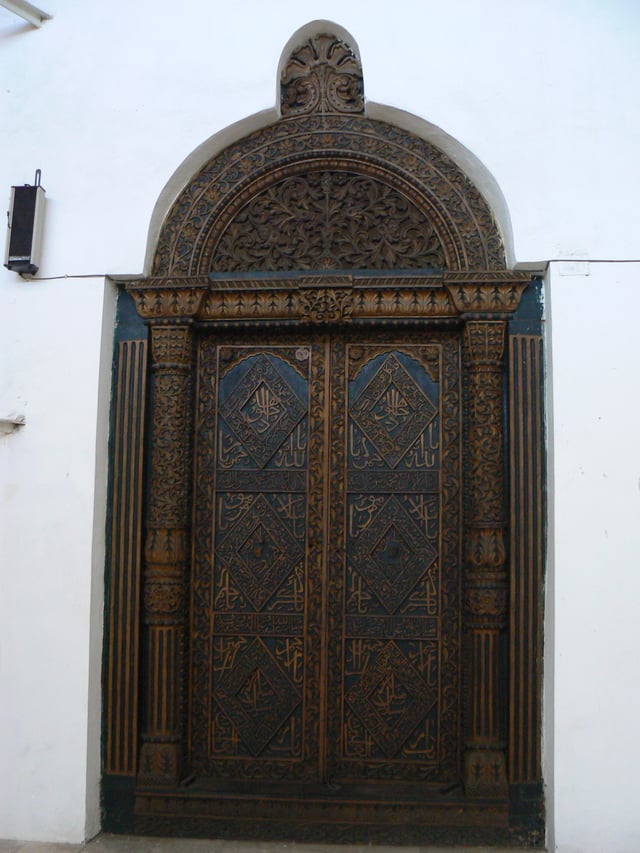
A carved door with Arabic calligraphy in Zanzibar
Swahili is used in parliamentary debate, in the lower courts, and as a medium of instruction in primary school. English is used in foreign trade, in diplomacy, in higher courts, and as a medium of instruction in secondary and higher education,[23] The Tanzanian government, however, has plans to discontinue English as a language of instruction.[25] In connection with his Ujamaa social policies, President Nyerere encouraged the use of Swahili to help unify the country's many ethnic groups.[169] Approximately 10 percent of Tanzanians speak Swahili as a first language, and up to 90 percent speak it as a second language.[23] Many educated Tanzanians are trilingual, also speaking English.[170][171][172] The widespread use and promotion of Swahili is contributing to the decline of smaller languages in the country.[23][173] Young children increasingly speak Swahili as a first language, particularly in urban areas.[174] Ethnic community languages (ECL) other than Kiswahili are not allowed as a language of instruction. Nor are they taught as a subject, though they might be used unofficially in some cases in initial education. Television and radio programmes in an ECL are prohibited, and it is nearly impossible to get permission to publish a newspaper in an ECL. There is no department of local or regional African Languages and Literatures at the University of Dar es Salaam.[175]
Arabic is co-official in Zanzibar.
Education
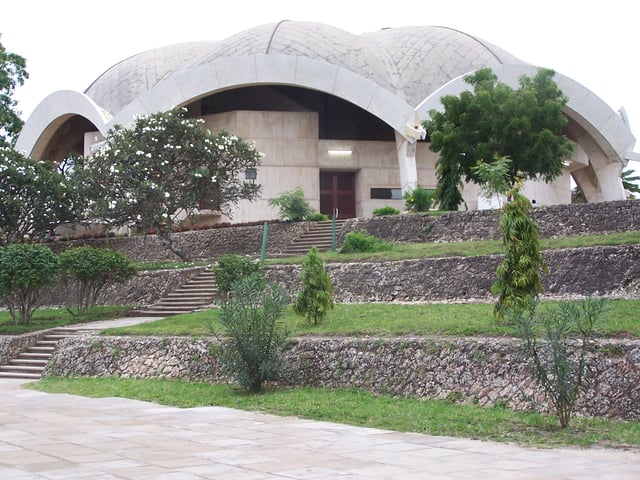
Nkrumah Hall at the University of Dar es Salaam
In 2012, the literacy rate in Tanzania for persons aged 15 and over was estimated to be 67.8 percent.[178] Education is compulsory until children reach age 15.[179] In 2010, 74.1 percent of children age 5 to 14 years were attending school.[179] The primary school completion rate was 80.8 percent in 2012.[179]
Healthcare
As of 2012, life expectancy at birth was 61 years.[180] The under-five mortality rate in 2012 was 54 per 1,000 live births.[180] The maternal mortality rate in 2013 was estimated at 410 per 100,000 live births.[180] Prematurity and malaria were tied in 2010 as the leading cause of death in children under 5 years old.[181] The other leading causes of death for these children were, in decreasing order, malaria, diarrhoea, HIV, and measles.[181]
Malaria in Tanzania causes death and disease and has a "huge economic impact".[182] [] There were approximately 11.5 million cases of clinical malaria in 2008.[182] [] In 2007–08, malaria prevalence among children aged 6 months to 5 years was highest in the Kagera Region (41.1 percent) on the western shore of Lake Victoria and lowest in the Arusha Region (0.1 percent).[182] []
According to the 2010 Tanzania Demographic and Health Survey 2010, 15 percent of Tanzanian women had undergone female genital mutilation (FGM)[164] [] and 72 percent of Tanzanian men had been circumcised.[164] [] FGM is most common in the Manyara, Dodoma, Arusha, and Singida regions and nonexistent in Zanzibar.[164] [] The prevalence of male circumcision was above 90 percent in the eastern (Dar es Salaam, Pwani, and Morogoro regions), northern (Kilimanjaro, Tanga, Arusha, and Manyara regions), and central areas (Dodoma and Singida regions) and below 50 percent only in the southern highlands zone (Mbeya, Iringa, and Rukwa regions).[164] []
2012 data showed that 53 percent of the population used improved drinking water sources (defined as a source that "by nature of its construction and design, is likely to protect the source from outside contamination, in particular from faecal matter") and 12 percent used improved sanitation facilities (defined as facilities that "likely hygienically separates human excreta from human contact" but not including facilities shared with other households or open to public use).[183]
Women
Women and men have equality before the law.[184] The government signed the Convention on the Elimination of All Forms of Discrimination against Women (CEDAW) in 1985.[184] Nearly 3 out of ten females reported having experienced sexual violence before the age of 18. [184] The prevalence of female genital mutilation has decreased.[184] School girls are reinstated back to school after delivery.[184] The Police Force administration strives to separate the Gender Desks from normal police operations to enhance confidentiality of the processing of women victims of abuse.[184] Most of the abuses and violence against women and children occurs at the family level.[184] The Constitution of Tanzania requires that women to constitute at least 30% of all elected members of National Assembly.[184] The gender differences in education and training have implications later in life of these women and girls.[184] Unemployment is higher for females than for males.[184] The right of a female employee to maternity leave is guaranteed in labour law.[184]
Culture
Literature
Tanzania's literary culture is primarily oral.[155] [] Major oral literary forms include folktales, poems, riddles, proverbs, and songs.[155] [] The greatest part of Tanzania's recorded oral literature is in Swahili, even though each of the country's languages has its own oral tradition.[155] [] The country's oral literature has been declining because of the breakdown of the multigenerational social structure, making transmission of oral literature more difficult, and because increasing modernisation has been accompanied by the devaluation of oral literature.[155] []
Books in Tanzania are often expensive and hard to come by.[155] [] [185] [] Most Tanzanian literature is in Swahili or English.[155] [] Major figures in Tanzanian written literature include Shaaban Robert (considered the father of Swahili literature), Muhammed Saley Farsy, Faraji Katalambulla, Adam Shafi Adam, Muhammed Said Abdalla, Said Ahmed Mohammed Khamis, Mohamed Suleiman Mohamed, Euphrase Kezilahabi, Gabriel Ruhumbika, Ebrahim Hussein, May Materru Balisidya, Fadhy Mtanga, Abdulrazak Gurnah, and Penina O. Mlama.[155] []
Painting and sculpture
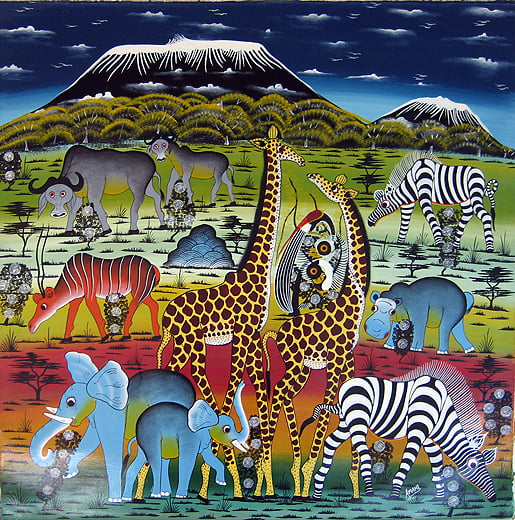
A Tingatinga painting
Two Tanzanian art styles have achieved international recognition.[185] [] The Tingatinga school of painting, founded by Edward Said Tingatinga, consists of brightly coloured enamel paintings on canvas, generally depicting people, animals, or daily life.[155] [] [185] [] After Tingatinga's death in 1972, other artists adopted and developed his style, with the genre now being the most important tourist-oriented style in East Africa.[155] [] [185] []
Sports
Other popular sports include basketball, netball, boxing, volleyball, athletics, and rugby.[186][188]
Cinema
Tanzania has a popular film industry known as "Bongo Movie".
See also
Index of Tanzania-related articles
Outline of Tanzania
Tanzania, a genus of African jumping spiders[189]
